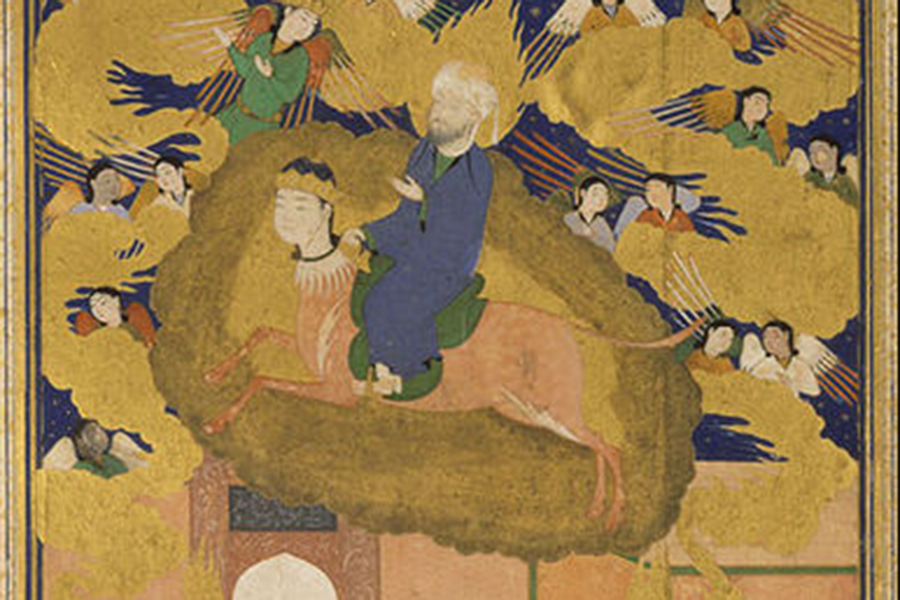Charlie Hebdo's cover and the more complicated truth of depictions of Muhammad
Loading...
Charlie Hebdo's first cover since last week's deadly attack didn't back down but got the tone right. In a time of great pain in France, a magazine whose cartoons on religion tend to provoke and degrade, struck a humanistic tone.
"All is Forgiven," says the headline in French over a representation of the prophet Muhammad, a tear rolling down his cheek. He holds a sign "I am Charlie," referring to the popular expression of solidarity with the weekly publication since 12 people died last Wednesday.
This was the second time the magazine had been targeted by Sunni jihadis over its representation of Muhammad. The killings by two French Muslim brothers who later died in an encounter with police, have ignited a global debate over censorship, offense, and freedom.
Today, many headlines and articles are questioning whether Charlie Hebdo's cover art could inspire more bloodshed. But that seems unlikely. This image is as inoffensive as a depiction of the Muslim prophet can be, unless the viewer is offended at the notion of him grieving over mass murder. And the small pool of would-be attackers already have an endless supply of ready-made reasons to attack almost any person or institution in the world that doesn't hew to their ideology.
Two days after the killings at Charlie Hebdo, another French jihadi who claimed to be working with the two brothers shot dead four Jews at a kosher grocery in Paris. They had apparently given just as much offense as the Hebdo cartoonists. All were murdered for their "offensiveness."
While the magazine's earlier images were, in many cases, deliberately insulting, this one is not – yet of course the jihadis will still complain.
And far too many non-Muslims will take this further complaint seriously – a form of victory for the terrorists. Not because editors and producers are acting out of fear. But because they've actually been convinced that most Muslims might view murder as a lesser sin than what amounts to drawing a stick figure with the word 'Muhammad' written beneath. In some ways, they've internalized the jihadis' minority opinion as representing the mainstream one in Islam.
Art Spiegelman, the illustrator and author of Maus, a comic about the Holocaust that depicts Jews as mice and the Nazis as cats, recalled later the outrage in Germany during his 1987 tour there. A German reporter "aggressively barked" at the son of two Jewish Auschwitz survivors: "Don't you think that a comic book about Auschwitz is in bad taste?," to which Spiegelman writes he replied: "No, I thought Auschwitz was in bad taste."
Devotional art and idolatry
In fact, Muslims both historically and today have had a wide range of views on the topic, and have produced some amazing art depicting Muhammad. (I'm particularly partial to this 16th Century devotional miniature from what is now Afghanistan of Muhammad's night flight from Mecca to Jerusalem.)
This is anathema to today's jihadis, whether they follow Al Qaeda or Islamic State. Their austere interpretation of Islam is shaped by the Wahabbi doctrine sponsored by Saudi Arabia and put to grim use by the Taliban.
The French killers thought that their faith directed them to murder indiscriminately the staff of a magazine. And they believe Islam calls for all Jews to be killed. Where do such beliefs originate? Well, no such calls are to be found either in the Koran nor in the writings credited to the sayings of Muhammad, called the hadith.
The origins of this debate lie in the faith's 7th-century founding. Mecca was once a pilgrimage site for worshipers of a variety of Gods, whose idols Muhammad destroyed after winning the city. The Koran is insistent and harsh on the great crime of idol worship – and this is where controversy arises over visual representations of the prophet.
While artistic depictions of Muhammad were commonplace for most of Islamic history, both Sunni and Shiite, in recent centuries the view has grown that depictions of Muhammad himself are a form of idolatry. Some Wahabbis say any depiction of the human form is deemed sinful for the same reason.
The House of Saud, rulers of Saudi Arabia's sacred sites since 1932, has destroyed hundreds of tombs, mosques and homes associated with Muhammad's early followers, arguing that they encourage idolatry. Last year there was even talk of destroying Muhammad's tomb, and removing any remains found there to an unmarked grave.
Unhappy birthday for Islamic State
The Islamic State, to which the French kosher store killer pledged allegiance, outlawed celebrations of Muhammad's birthday last month in the parts of Syria and Iraq they control on pain of death. This date is an important mawlid, or feast day, for tens of millions of Muslims. A suicide bomber from Al Qaeda in the Arabian Peninsula murdered over 30 Muslims celebrating his birthday in Yemen on Dec. 30.
Then there's the sectarian divide within Islam. Follower of Al Qaeda and their ilk take offense at the beliefs and practices of 200 million or so Shiites in the world. Punishment is death. Ditto for Muslims who vote in elections – of which there are already in excess of 200 million.
In short, there's a great deal that extremists take offense at, and will kill over, much of it treasured beliefs and institutions within the Muslim mainstream.
The first spasms of outrage over European cartoons erupted a decade ago when Denmark's Jyllands-Posten published a series of Muhammad cartoons, one of them depicting the prophet as a suicide bomber. How it unfolded is instructive when weighing up the debate over Charlie Hebdo's offensiveness.
A group of Wahabbi-style Danish imams complained to the government about the cartoons and demanded action. They were understandably ignored. The cartoons were published in Egypt's al-Fajr newspaper (to condemn them as offensive) and in an Indonesian daily, Rakyat Merdeka. Teguh Sentosa, the paper's online editor put the suicide bomber cartoon on its website not once, but twice, to see if people would care. By and large, they didn't.
The Danish imams then decamped on a world tour of Muslim majority states with a dossier of cartoons, some of which were dramatically more offensive than anything the Danish paper had run (the prophet as a pig; the prophet having sex with an animal; as a horned pedophile, etc...). They also emphasized what they claimed were pervasive and common attacks on Islam in Denmark.
By the end of the year, they had gotten what they wanted. Not only had they dramatically expanded the audience for cartoons of Muhammad, some that had never been published anywhere before, they also created an international storm and calls for a boycott of Danish goods. This got the ball rolling to where we are today, accepting as gospel that all depictions of the prophet are now and always have been offensive to all Muslims.
Tell that Teguh Sentosa. He stayed on at Rakyat Merdeka and in 2009 took a second job as a lecturer at the government-run Syarif Hidayatullah Islamic University in Jakarta.








